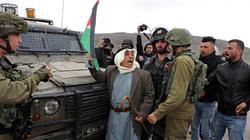 Palestinians have staged protests in the West Bank to denounce fresh Israeli land theft schemes after the regime’s bulldozers apparently began preparing a piece of land in the northern part of the occupied territories for settlement expansion.
Palestinians have staged protests in the West Bank to denounce fresh Israeli land theft schemes after the regime’s bulldozers apparently began preparing a piece of land in the northern part of the occupied territories for settlement expansion. RNA - Israeli bulldozers have been working in a field in close proximity to the Migdalim settlement, located 45 kilometers from Tel Aviv and adjacent to the Palestinian hamlet of Qusra, promoting anger among the Palestinians who believe the regime is planning to seize more occupied land.
Palestinian protesters from the village of Qusra challenged Israeli forces guarding the bulldozers.
For several days, residents of the town of Beita, in the Nablus Governorate, have been holding demonstrations, planting a Palestinian flag and erecting a tent on the hilltop of al-Arma to defend it against settlers from the Itamar settlement, with some of the protesters hurling rocks at Israeli troops.
An Israeli army statement said the regime forces had intervened and used “riot” dispersal means after Palestinians hurled rocks, burned tires and “came into physical confrontation” with the settlers, who were carrying out “agricultural work” near Migdalim.
“I came here because this is my land, and I want to die on my land but they are not letting me come near it,” said 70-year-old Qusra resident Joudat Odeh.
“They are happy at the victory of [Israeli Prime Minister Benjamin] Netanyahu,” Odeh added. “They are coming to control this land and we are helpless.”
There have been a rise in tensions in the occupied West Bank as Netanyahu’s Likud Party is leading in the general elections held on Monday.
Although Netanyahu has claimed victory in the third such elections in less than a year, but his right-wing bloc has failed to secure a 61-seat majority he needs to form an administration and end a political deadlock gripping the regime in Tel Aviv.
The Palestinians view Netanyahu’s win as a sign of more land grab to come. The Israeli regime has been sharply emboldened by US President Donald Trump’s pro-Israel polices, the latest of which is a contentious plot Trump unveiled last month with the aim of legitimizing Israel’s occupation and re-drawing the Middle East map.
The scheme, crafted to end the Israeli-Palestinian conflict, meets Israel’s demands while creating a Palestinian state with limited control over its own security and borders.
The plan — drawn up in close cooperation with the Netanyahu administration — bars Palestinian refugees from returning to their homeland while enshrines Jerusalem al-Quds as “Israel’s undivided capital” and allows the regime to annex settlements and the Jordan Valley.
During his campaign, Netanyahu vowed to swiftly annex West Bank settlements and the Jordan Valley if he won a fifth term in office.
Last month, he announced that 3,000 settler units would be built in East Jerusalem al-Quds’ Givat HaMatos area in addition to another 2,200 in the nearby Har Homa neighborhood.
‘Netanyahu’s win means victory for annexation’
Addressing the 153rd session of the Arab League Council in Cairo on Wednesday, Palestinian Foreign Minister Riyad al-Maliki stressed that the US and Israel have to “bury this plan” and return to international law and the agreed basis for negotiations.
Netanyahu’s election win is “a victory for the policies of land annexation, confiscation and settlement,” he said, adding that it means “more violence, repression, racism and fascism.”
Maliki also noted that Netanyahu’s victory will thwart the possibility of an independent, geographically viable, and sovereign Palestinian state on the 1967 boundaries with East Jerusalem (al-Quds) as its capital.
The Palestinian people are facing “the most brutal forms of repression and abuse ... in a brutal exploitation of the deal of the century to implement the largest number of expansionist colonies in our occupied land, and to continue imposing an unjust blockade on the Gaza Strip, in addition to judaizing Jerusalem (al-Quds) and its holy sites,” he said.
847/940